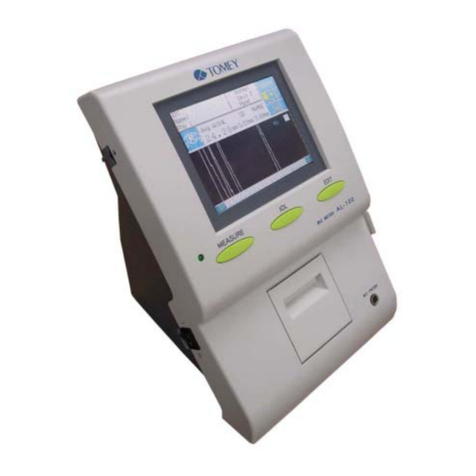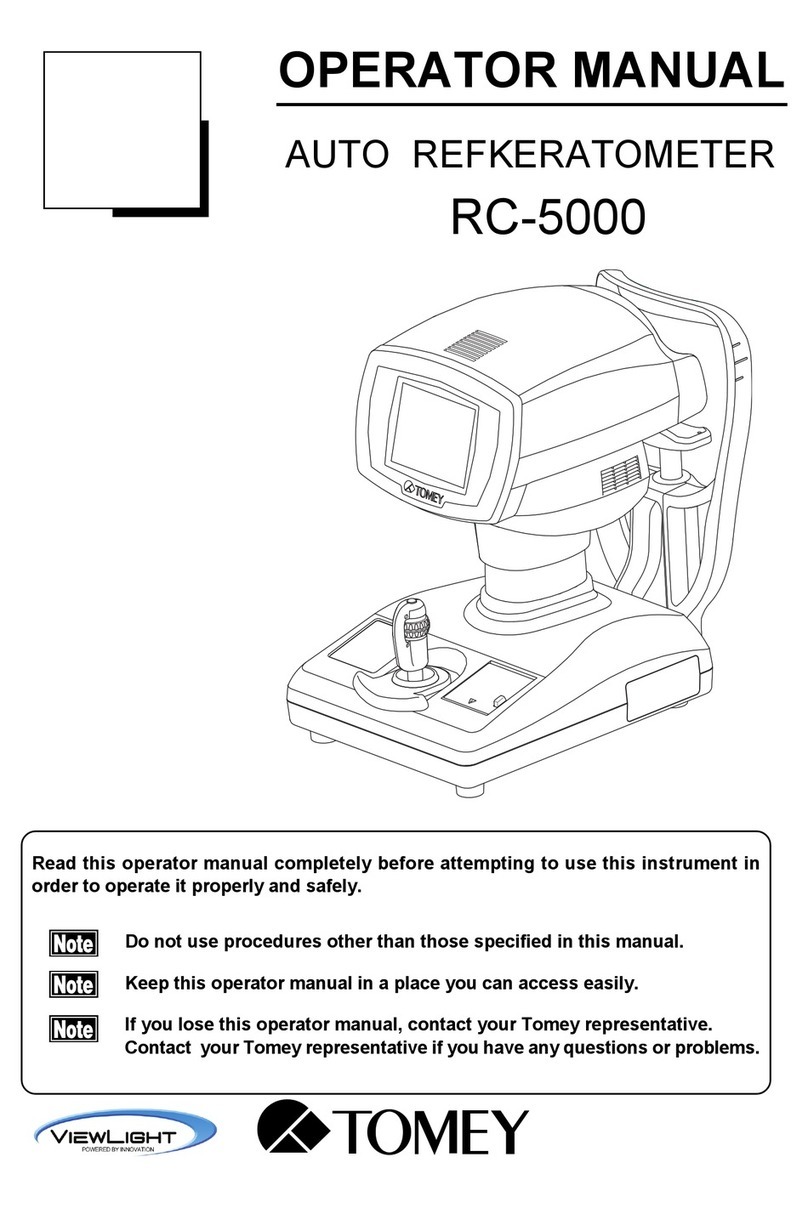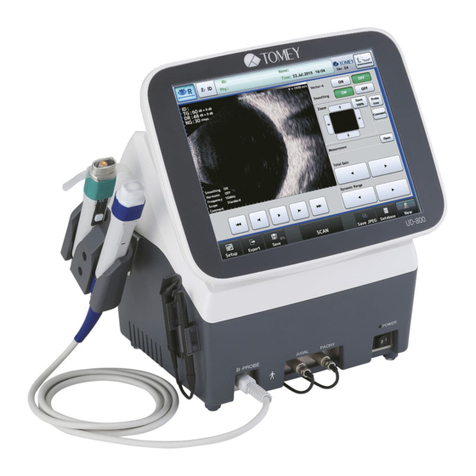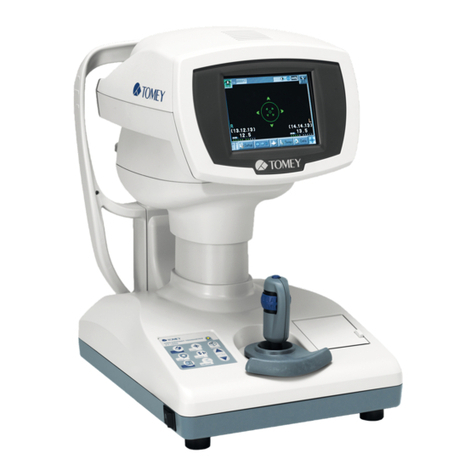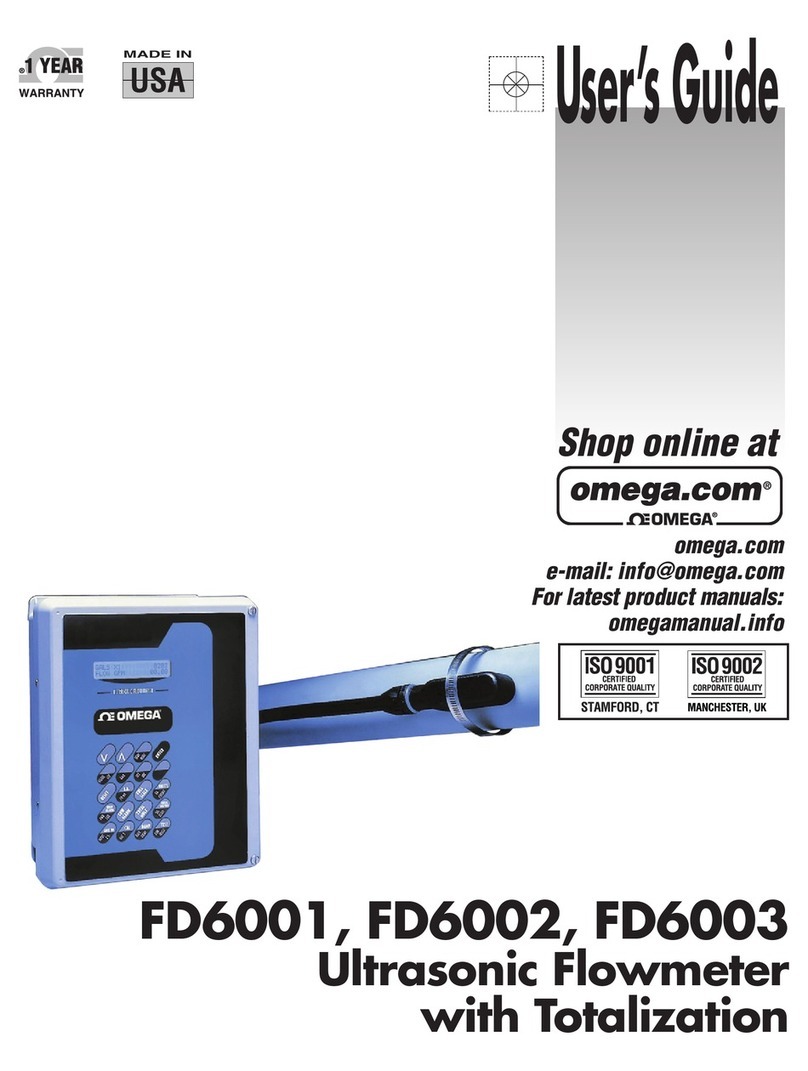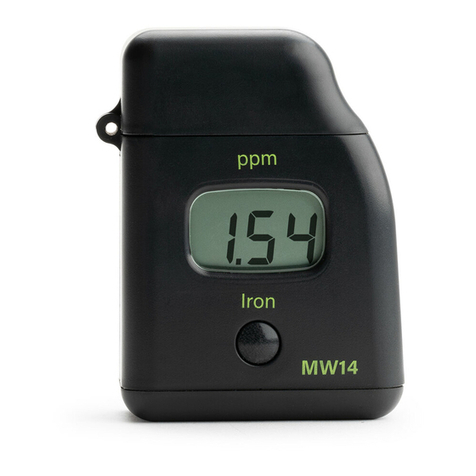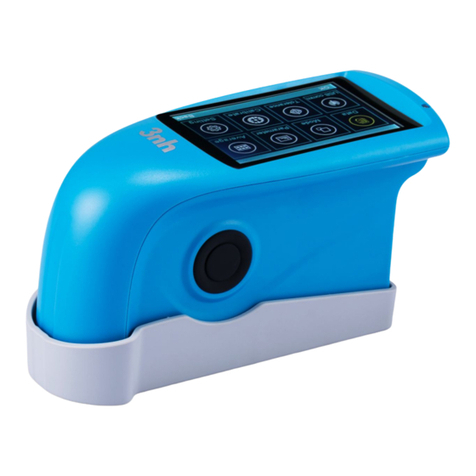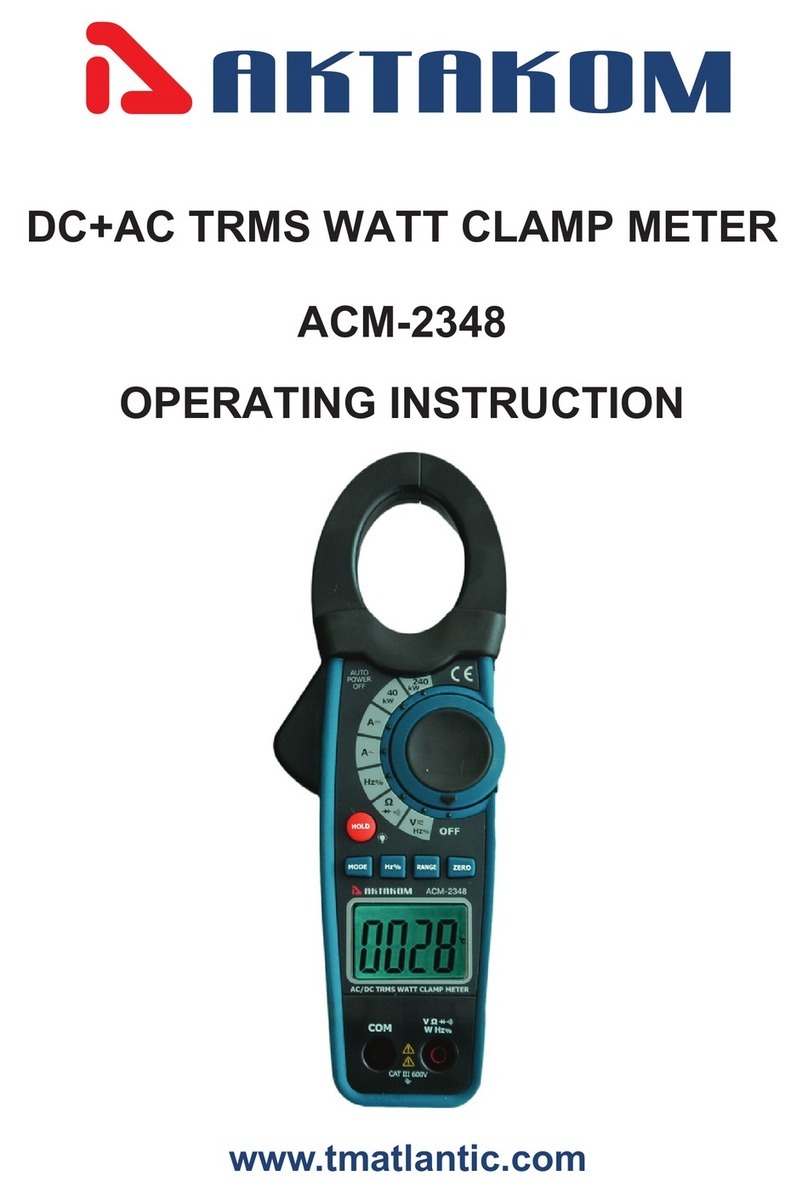Tomey RC-800 User manual

INSTRUCTION MANUAL㻌
AUTO REFKERATOMETER
RC-800
288A9090-00
Read this manual thoroughly before using the
instrument to ensure proper and safe operation.
Contact Tomey Corporation or our local distributor
if you have any questions or you encounter any
problems during operation.
䕔Always follow the operation procedures
described in this manual.
䕔Keep this manual in a readily
accessible location while operating the
instrument.
䕔Contact our local distributor if you lose
this manual.


To our customers
This is a medical instrument used to measure the objective refraction and radius of corneal
curvature.
Although PD measurement, corneal diameter/pupil diameter measurement, and CL base
curve diameter measurement features are loaded as optional functions, the validity of those
measurements is not guaranteed.
It is recommended that those measurements be performed with dedicated instruments.

This page is intentionally left blank.

i-1
䕔
i Important Safety Information
ڦ
Do not install this instrument in a location where explosives or
inflammable substances are used or stored. Otherwise, fire or
explosion may occur.
ڦ
Do not remove the cover of the instrument.
You may be directly
exposed to high voltage sections.
ڦ
Do not disassemble or modify the instrument.
You may be directly
exposed to high voltage sections.
ڦ
Disconnect the power cord from the instrument before servicing
the instrument. Otherwise, you may get an electric shock.
ڦ
Do not place water or chemicals on the instrument.
Any water or
chemicals entering the instrument may cause an electric shock or
failure.
ڦ
Only use the specified terminal for connection of the instrument.
Using another type of terminal may result in failure of the
instrument.
ڦ
This instrument is a diagnostic/measuring device specially
designed for ophthalmology.
Never use the instrument for other
purposes.
ڦ
The external output terminal is not isolated from the internal circuit.
Inappropriate wiring may damage the internal circuit.
Never touch
any of these terminals and the patient at the same time. Be sure to
contact Tomey or our local distributor before using the external output
terminal.
ڦ
When operating this instrument connected to other devices, only use
devices that satisfy IEC60601-1 or equivalent safety requirements, or
that conform to IEC60950 and whose power source is insulated with
an isolation transformer, in order to satisfy the relevant safety
requirements for medical equipment.

䕔
㻌
i-2
ڦ
Never mark or damage the caution labels on the instrument. Caution
labels are provided on the side and at the bottom of the main unit (1 in
each location).
ڦ
Contact Tomey or our local distributor when a label is damaged or
becomes illegible.
i-1ᴾ

ii-1
䕔
ii How to read this manual
Outline
This manual is structured as follows.
1. PRIOR TO USE
Describes safety precautions and important
information to be understood before installing and
using the instrument.
2. NAMES AND FUNCTIONS
Describes names and functions of each section of
the instrument.
3. OPERATION PROCEDURES
Describes information required for installing and
using the instrument.
4. TECHNICAL INFORMATION
Describes useful technical information about the
instrument.
5. INSPECTION AND MAINTENANCE
Describes procedures for replacing consumable
parts, etc. that the user of the instrument should
normally conduct.
6. TROUBLESHOOTING
Describes how to solve problems.
7. CONSUMABLES
Describes consumable parts and optional equipment.
8. SPECIFICATIONS
Describes the specifications of the instrument.
9. INDEX
Refer to the index when needed.

䕔
㻌
ii-2
SYMBOLS USED IN THIS MANUAL
Sentences accompanied with the symbols below indicate
the following:
ڦ
This is a precaution that, if unheeded, will result
in a hazardous situation where there is an
imminent danger of serious injury or death.
ڦ
This is a precaution that, if unheeded, could
result in a hazardous situation where there is a
possibility of serious injury or death.
ڦ
This is a precaution that, if unheeded, may result
in a situation where there is a possibility of minor
or moderate injury or damage to property.
ڦ
This is an additional instruction which may
contain a special precaution on company policy
related, either directly or indirectly, to the safety
of personnel or to the protection of property.

iii-1
䕔
iii Contents
i Important Safety Information ....................................................................................... i-1
ii How to read this manual ............................................................................................. ii-1
Outline............................................................................................................................ ii-1
SYMBOLS USED IN THIS MANUAL ............................................................................. ii-2
iii Contents .................................................................................................................... iii-1
1. PRIOR TO USE ..........................................................................................................1-1
1.1 Precautions for operation .........................................................................................1-1
1.2 Checking package contents .....................................................................................1-6
1.3 Glossary ...................................................................................................................1-7
1.4 Overview ..................................................................................................................1-9
2. NAMES AND FUNCTIONS.........................................................................................2-1
2.1 Physician's side........................................................................................................2-1
2.2 Patient's side ............................................................................................................2-3
2.3 Measurement screen ...............................................................................................2-4
2.4 Operation of the joystick...........................................................................................2-6
2.5 Symbols ...................................................................................................................2-7
3. OPERATION PROCEDURES ....................................................................................3-1
3.1 Safety precautions ...................................................................................................3-1
3.1.1 Precautions for installing the instrument ............................................................3-1
3.1.2 Precautions for connecting the power cord........................................................3-2
3.1.3 Connecting the power cord................................................................................3-2
3.1.4 Checking the printer paper ................................................................................3-3
3.1.5 Connecting optional components.......................................................................3-3
3.2 Preparation before use.............................................................................................3-5
3.2.1 Startup ...............................................................................................................3-5
3.2.2 Selecting the mode and setting measurement conditions..................................3-6
3.2.3 Adjusting patient position ...................................................................................3-7
3.2.4 Auto Shot ...........................................................................................................3-8
3.3 Measurement .........................................................................................................3-10
3.3.1 Eye refractive power (refractometer) measurement.........................................3-10
3.3.2 Measuring the radius of corneal curvature (keratometry) ................................3-13

䕔
㻌
iii-2
3.3.3 Measuring the eye refractive power and radius of corneal curvature
(refkeratometer measurement) ........................................................................3-16
3.3.4 Corneal diameter and pupil diameter measurement ........................................3-18
3.3.5 Contact lens measurement..............................................................................3-20
3.4 Printout...................................................................................................................3-21
3.4.1 Printing procedures..........................................................................................3-21
3.4.2 Printing format .................................................................................................3-22
3.5 Showing and deleting data in memory ...................................................................3-26
3.6 Data communication using TOMEY Link and DATA Transfer .................................3-27
3.6.1 Entering patient information.............................................................................3-28
3.6.2 Sending examination data ...............................................................................3-31
3.6.3 All clear of measurement data (preparation for measuring a new patient).......3-33
3.7 Data communication using TOMEY FORM ............................................................3-34
3.8 Setting measurement conditions ............................................................................3-35
3.8.1 Setup ...............................................................................................................3-35
3.8.2 Temporary setup ..............................................................................................3-43
3.9 Language selection ................................................................................................3-45
4. TECHNICAL INFORMATION......................................................................................4-1
5. INSPECTION AND MAINTENANCE ..........................................................................5-1
5.1 Warranty...................................................................................................................5-1
5.2 Operation life............................................................................................................5-2
5.3 Inspection.................................................................................................................5-2
5.4 Routine maintenance ...............................................................................................5-3
5.5 Replacing consumables ...........................................................................................5-4
5.5.1 Printer paper......................................................................................................5-4
5.5.2 Fuses.................................................................................................................5-5
5.5.3 Chin rest paper ..................................................................................................5-6
5.6 Storing ......................................................................................................................5-7
5.7 Disposal ...................................................................................................................5-8
6. TROUBLESHOOTING................................................................................................6-1
7. CONSUMABLES ........................................................................................................7-1
8. SPECIFICATIONS......................................................................................................8-1
8.1 Specifications ...........................................................................................................8-1

iii-3
䕔
8.1.1 Refractive power measurement.........................................................................8-1
8.1.2 Corneal curvature measurement .......................................................................8-1
8.1.3 Pupillary distance measurement........................................................................8-2
8.1.4 Corneal diameter and pupillary diameter measurement ....................................8-2
8.1.5 Observation range .............................................................................................8-2
8.1.6 Main unit ............................................................................................................8-2
8.1.7 Power source.....................................................................................................8-2
8.2 Environmental conditions .........................................................................................8-3
8.3 Classification ............................................................................................................8-3
8.4 Declaration of conformity to EMC.............................................................................8-4
9. INDEX.........................................................................................................................9-1

䕔
㻌
iii-4
This page is intentionally left blank.

1-1
䕔
1. PRIOR TO USE
ڦ
Read this manual thoroughly before using this instrument to ensure
proper and safe operation.
ڦ
Always follow the operation procedures described in this manual.
ڦ
Check that there are no devices that generate strong magnetic field
near the instrument.
A strong magnetic field may cause noise and
affect measurement.
ڦ
Do not place any other objects on this instrument.
1.1 Precautions for operation
ڦ
Only allow qualified operators to use the instrument.
ڦ
Precautions when installing the instrument
-Install the instrument in a location free of water or chemicals.
Any water
or chemicals entering the instrument may cause an electric shock or
failure.
-Do not install the instrument in a location where chemicals are stored or
gases may occur.
Spilt chemicals or vapor may enter the instrument and
result in fire.
-Check that the frequency, voltage, and allowable current (or power
consumption) of the power source are appropriate.Otherwise, fire or
electric shock may occur.
-Connect the power plug to a grounded 3-pin outlet.Otherwise, a short
circuit due to failure of the instrument may result in electric shock.
-Do not place any heavy object on the power cord or squash the power
cord.Fire or electric shock may occur.
-Fully insert the power plug into the outlet.Faulty contact, allowing any
metal to contact the exposed terminal of the plug, or dust accumulated
on the exposed terminal of the plug may result in fire or electric shock.
-Conduct grounding work correctly.Otherwise you may get an electric
shock.
-Do not connect a device with data transmission specifications that are
not compatible.Fire or electric shock may occur.Contact Tomey

䕔
㻌
1-2
Corporation or our local distributor before using the instrument while
connected to another device.
-Install the instrument in a location not subject to direct sunlight, high
temperature and humidity, or air containing dust, salt, and/or sulfur.
Otherwise, failure or malfunction may occur.
-Install the instrument in a leveled stable location free of vibration or
mechanical impact.Otherwise, measurement cannot be conducted
correctly.Also, the instrument may topple over or fall down, resulting in
fire or a serious accident.
-Check the battery power source (discharge condition, polarity, etc.).
-Do not hold the head, chin rest, forehead pad, or joystick when moving
the instrument.These components are detachable and the instrument
may drop, resulting in injuries.
ڦ
Precautions before using the instrument
-Check that the instrument works properly by inspecting switch and
button operations, display, and printing.
-Check that the instrument is correctly grounded.
-Check that all cables are connected correctly.
-Check the sections that the patient will directly touch.
-Peel off the top sheet of chin rest paper and clean the forehead pad with
a cloth dampened with alcohol before measurement.
-Check that the date set in the instrument conforms to the actual
operation date and time.
ڦ
Precautions during operation
-Do not place any container with liquid in it on the instrument.
Any liquid
entering the instrument may cause electric shock or failure.
-Do not allow the patient to touch the terminals for connecting the
instrument to external devices.
-If a measurement of the radius of corneal curvature which is considered
questionable due to the following is used to select intraocular lenses,
further surgery might be required.
In this case, it is necessary to review
the of examination result by analyzing the shape of the cornea.
࣭The error code (E) is added to the measured value.

1-3
䕔
࣭There is a significant difference between the radii of corneal
curvature of the left eye and the right eye.
࣭The degree of the calculated intraocular lenses is one that is less
frequently used, or is out of the normal range.
-Note that if diopter is used as the measurement unit for the radius of
corneal curvature, the measured value may differ depending on the
cornea equivalent refractive index.
This instrument uses the value n = 1.3375.
If an incorrect value is used to select intraocular lenses, further surgery
might be required.
-Be sure to press the CLEAR button on the main unit to delete the
measurement data of the previous patient before measuring a new
patient.
If new measurement is started without deleting the previous
data, the measurement data for the previous patient may be included.
-When moving the measuring head and/or chin rest of the instrument,
pay attention to the position of the patient's face, hands, and fingers.
The patient may be injured by the moving section of the instrument.
-Do not allow any person to place their hands or fingers in the clearance
of the moving section of the main unit or the section immediately under
the chin rest.
Their hands or fingers may be caught and injured.
-Do not lean on the instrument or press the instrument from the top.
The
instrument may topple over, resulting in mechanical failure or injuries.
-Be extremely careful not to delay measurement unnecessarily, as this
can stress the patient.
-Always check that there is no problem with the instrument and patient to
ensure safety.
-This is an eye measurement instrument used to measure the eye
refractive power and radius of corneal curvature. Although PD
measurement, corneal diameter/pupil diameter measurement, and CL
base curve diameter measurement features are loaded as optional
functions, the validity of those measurements is not guaranteed. It is
recommended that those measurements be performed with special
purpose instruments.
-If any problem is found with the instrument or patient, take appropriate
action, such as stopping operation, to maintain patient safety.

䕔
㻌
1-4
-Do not use the refractive power, radius of corneal curvature, PD value,
residual astigmatism, and base curve measurement for contact lenses
directly to prescribe glasses or contact lenses.
This could cause eye
strain or corneal disorder.
Other examination methods should also be
used in conjunction with the above.
-Never touch the cutter in the printer.
Touching this can cause injuries.
-Peel off the top sheet of chin paper and clean the forehead pad with a
clean cloth before measuring the next patient.
Clean the forehead pad
and chin rest with a cloth dampened with alcohol as needed.
-If any smoke, offensive odor, or abnormal sound occurs, turn off the
instrument immediately, disconnect the power plug from the outlet, and
contact our local distributor or Tomey Corporation.
ڦ
Precautions after operation
-Do not place any container with liquid in it on the instrument.
Any liquid
entering the instrument may cause electric shock or failure.
-Do not use organic solvents such as thinner, benzene, or acetone to
clean the instrument.
Fire or electric shock may occur.
(They may also
corrode the resin or coating of the cover of the instrument.)
㸧
-When disconnecting cords, do not apply excessive force on them; for
example, do not hold and pull the cord to disconnect it. Disconnect the
power cord from the outlet to ensure safety when the instrument is not
operated for 1 month or longer.
-Hold the plug when disconnecting the power plug from the outlet to
avoid placing excessive force on the cord.
Pulling the cord may damage
the inner core wires, resulting in electric shock or fire.
-Refer to “5.6 Storing” for instructions on the storage of the instrument.

1-5
䕔
ڦ
If any failure occurs in the instrument, immediately stop operation,
indicate the failure in the instrument, and contact our local distributor
for repairs.
-Do not modify the instrument.
Doing so may cause electric shock or
failure of the instrument.
There is a high-voltage section in the
instrument. Touching this section will result in death or serious injuries.
-Disconnect the power cord from the outlet when replacing fuses.
Otherwise, you may get an electric shock, resulting in death or serious
injuries.
-Use the power cord and fuses provided with the instrument or specified
by Tomey to ensure safety. Also, do not use the accessories provided
with the instrument for other equipment.
-Conduct regular inspections of the instrument.
-When the instrument is not used for 1 month or longer, check that the
instrument is operating correctly and safely before starting operation.
Refer to “5.3 Inspection” in this manual for the relevant procedures.

䕔
㻌
1-6
1.2 Checking package contents
Open the package and check that the required quantity of
the following items is included and they are not damaged.
If any item is missing or damaged, contact our local
distributor as soon as possible.
ڦ
Keep the box and packing materials for use when
moving or transporting the instrument.
ڦ
When taking the instrument out of the box, pull
the outer box upward and then remove the
packing materials.
Be careful not to lift the
instrument by directly holding the measuring
head, chin rest, forehead pad, or joystick. The
instrument may be damaged.
ƔMain unit AUTO REFKERATOMETER RC-800 ......... 1
ƔPower cord................................................................. 1
ƔModel eye .................................................................. 1
ƔFuse (2 fuses are installed in the main unit)............... 4
ƔChin rest paper .......................................................... 1
ƔPins for chin rest paper .............................................. 2
ƔPrinter Paper (One is already installed) ..................... 3
ƔCL holder ................................................................... 1
ƔDust cover.................................................................. 1
ƔInstruction manual (this manual) ................................ 1
ƔDATA Transfer installation CD .................................... 1
ƔDATA Transfer installation guide ................................ 1

1-7
䕔
1.3 Glossary
[A / AX / AXIS] : Astigmatism axial angle [0° - 180°]
Represents the direction where a degree of astigmatism is present;
the degree will be applied where it intersects at right angles with the
astigmatism axis.
[AS] : Auto Shot
[AVG] The average radius of corneal curvature taken from the major and
minor meridians.
[mm or D]
[C/CYL] : Cylindrical refractive power [D]
[CAT mode] : Cataract eye measurement mode in refractometer measurement
[CL mode] : The mode used when measuring the base curve of hard contact
lenses
[CORNEA] : Shows the corneal diameter in the [DIA] mode for corneal diameter
measurement/pupil diameter measurement.
[DATA Transfer] : System to output the examination data created by TOMEY products
as a file
[IOL mode] : The mode used for eyes wearing IOL during refractometer
measurement
[K1] : Radius of corneal curvature of minor meridian [mm or D]
[K2]: Radius of corneal curvature of major meridian [mm or D]
[PD] : Pupil distance [mm].
[PUPIL] : Shows the pupil diameter in the [DIA] mode for corneal diameter
measurement/pupil diameter measurement.
[RA] : Residual astigmatism (see “Residual astigmatism”)
[S/SPH] : Spherical refractive power [D]
[SE] : Equivalent spherical degree (see “Equivalent spherical degree”).
[Temporary] : Function to temporarily change the measuring condition(s)

䕔
㻌
1-8
[TOMEY Link] : Digital medical record system to control the data measured with
Tomey products
[VD] : Vertex distance [mm]
Represents the distance between the corneal vertex and the
posterior surface of the lenses to be prescribed.When (VD=CL),
vertex distance is calculated as 0 mm.
[Auto Shot]:Function to automatically perform measurement when the sight in the
up/down/right/left/focus directions becomes optimum
[Auto power off
function]
:Function to automatically turn the LCD off, with only the power lamp
flashing, when the instrument is not operated for the specified time
(Auto Power Off mode).
Touch any button to return to Normal mode.
[High-speed
mode]
:Cloudy fog is automatically applied when starting refractometer
measurement. The actual measurements are performed
consecutively while maintaining the cloudy fog.
This is effective for patients with unstable sight.
[Auto Fogging]:Method used to intentionally defocus the fixation target to remove
adjustment of the crystal lens.
[Touch panel]:Allows you to make various settings by directly touching the monitor.
[Target
center-point]
:Name of the reflection in the center of cornea
[Residual
astigmatism]
:Degree of astigmatism calculated as residual, by assuming that the
patient is wearing virtual hard contact lenses calculated from
auto-refractometer and keratometer values.
Therefore, the value may differ from “total astigmatism - corneal
astigmatism.”
[Equivalent
spherical degree]
:Calculated from the refractometer value SPH+CYL/2
Table of contents
Other Tomey Measuring Instrument manuals
Popular Measuring Instrument manuals by other brands

PCB Piezotronics
PCB Piezotronics IMI SENSORS 623C10 Installation and operating manual
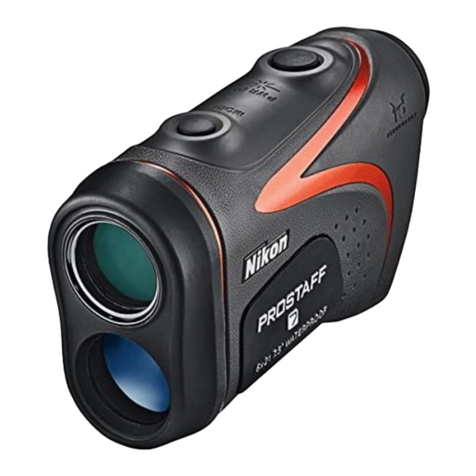
Nikon
Nikon PROSTAFF 7 instruction manual
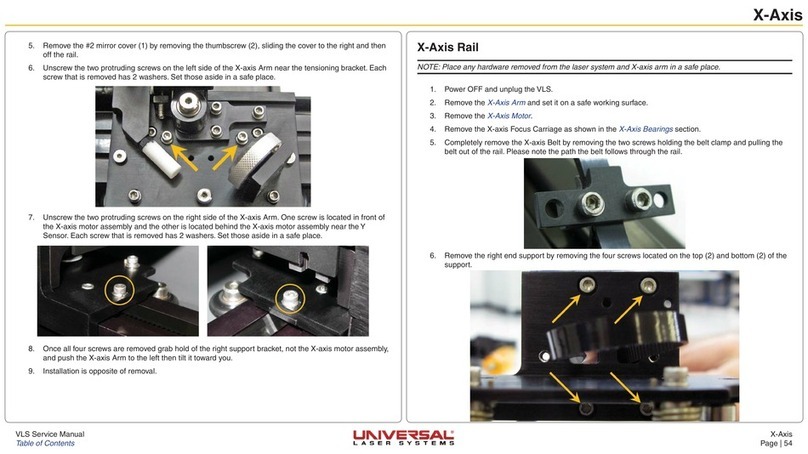
Universal Laser Systems
Universal Laser Systems X-Axis Service manual

SOMMER
SOMMER RQ-30 ADMS quick start guide

AGILTRON
AGILTRON 1550nm Operation manual
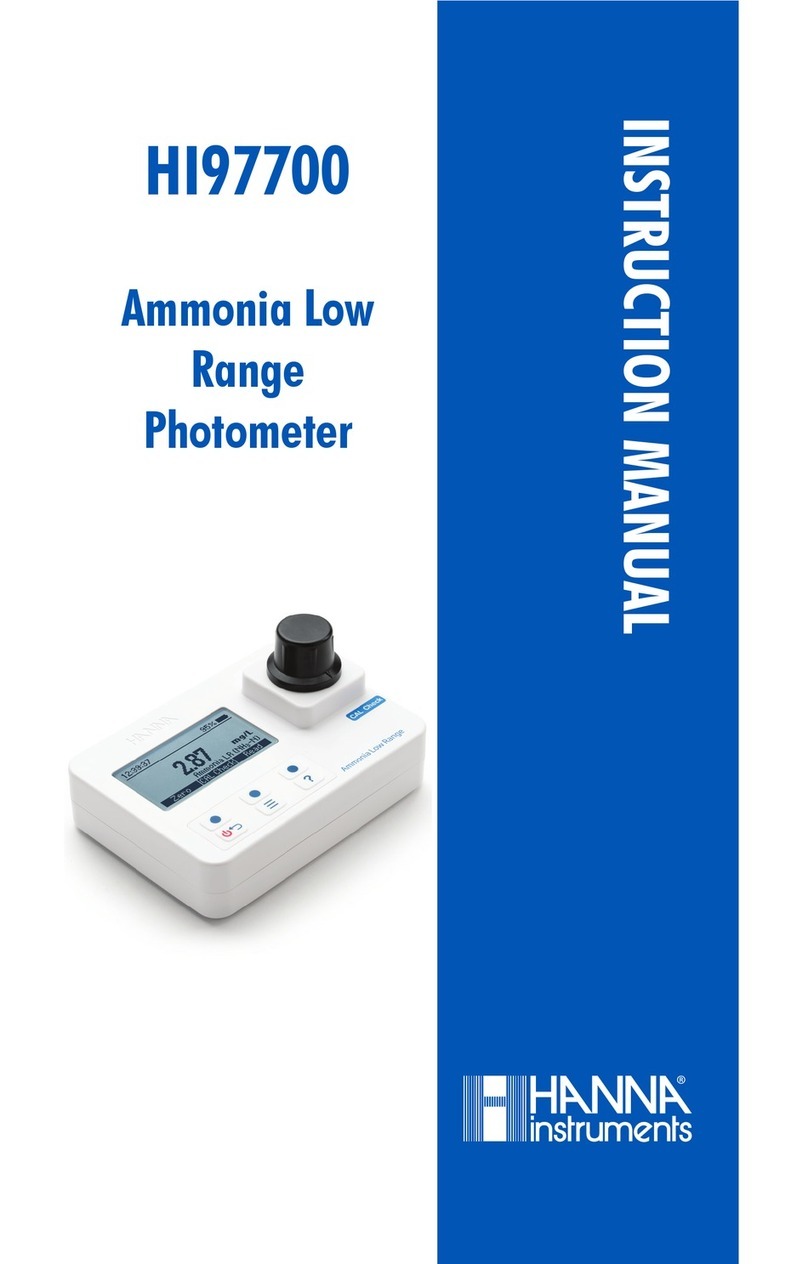
Hanna Instruments
Hanna Instruments HI97700 instruction manual
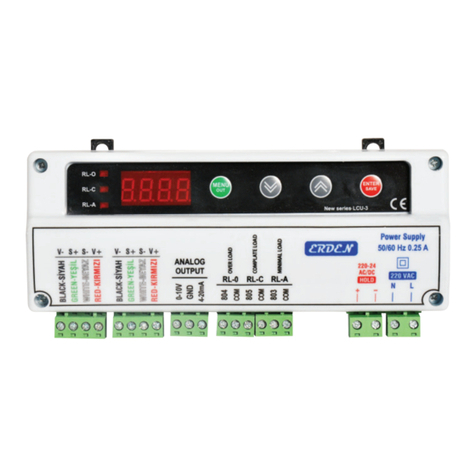
Erden
Erden ERD-4 manual
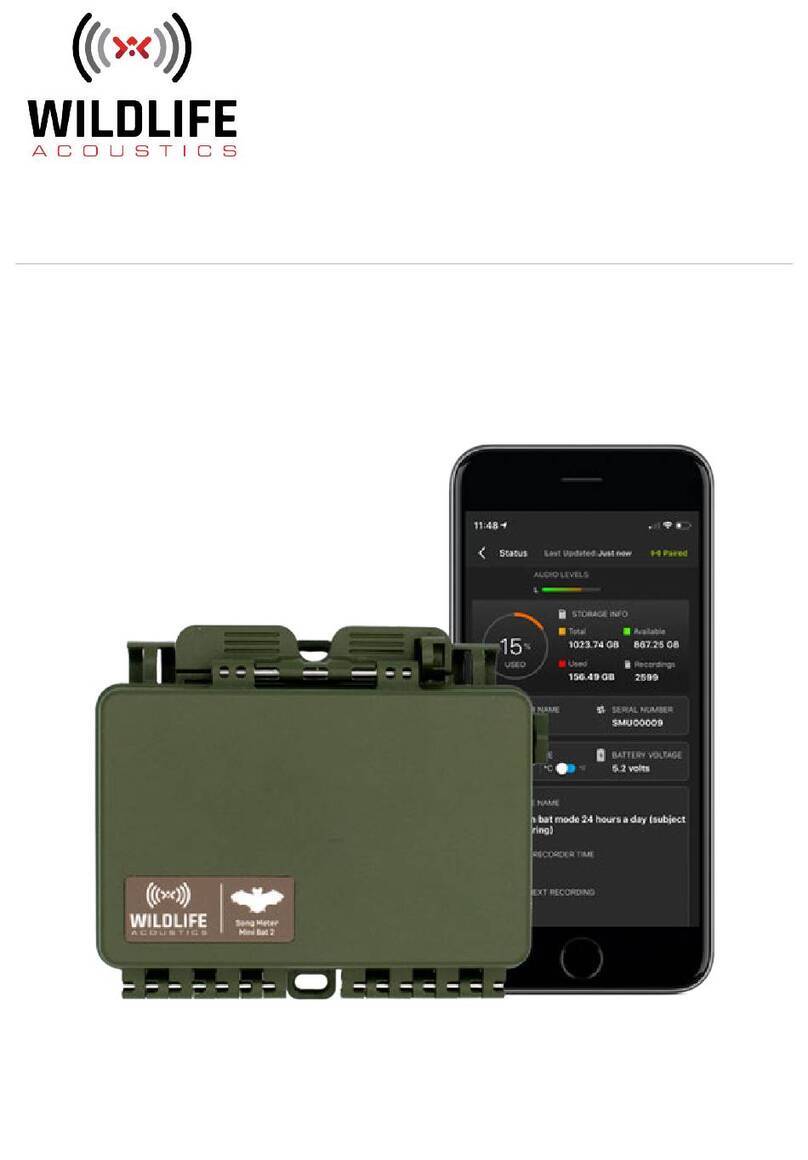
Wildlife Acoustics
Wildlife Acoustics Song Meter Mini Bat 2 user guide
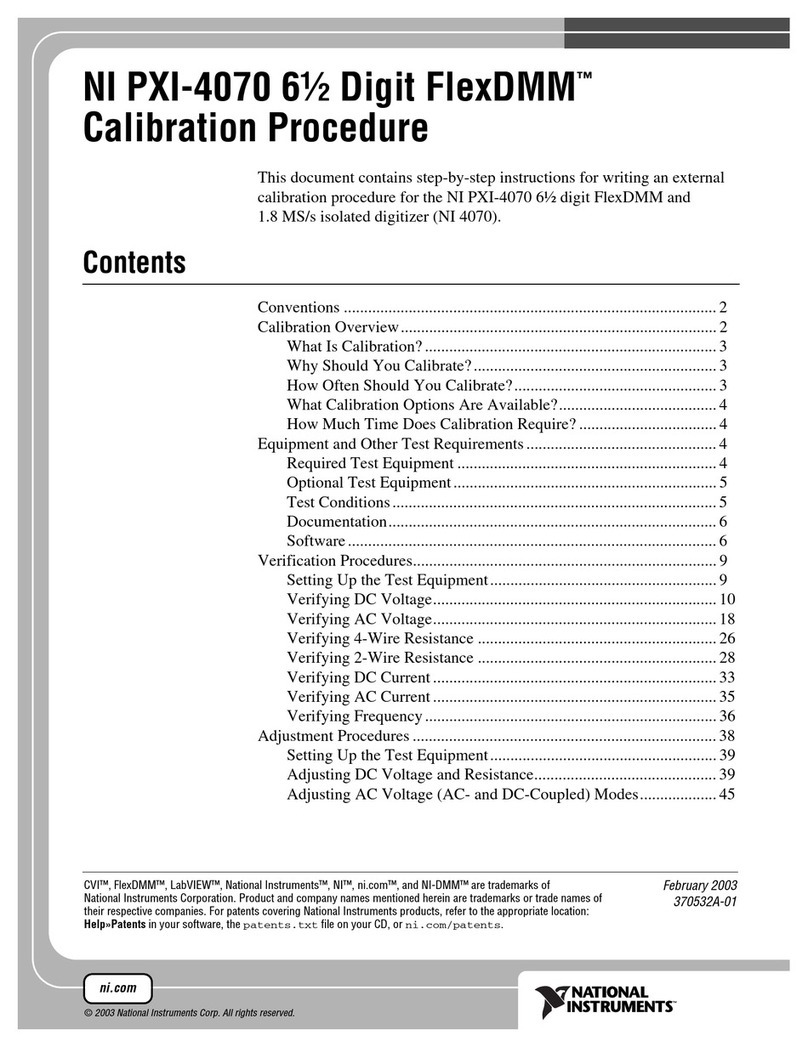
National Instruments
National Instruments PXI-4070 6 1/2 Digit FlexDMM CALIBRATION PROCEDURE
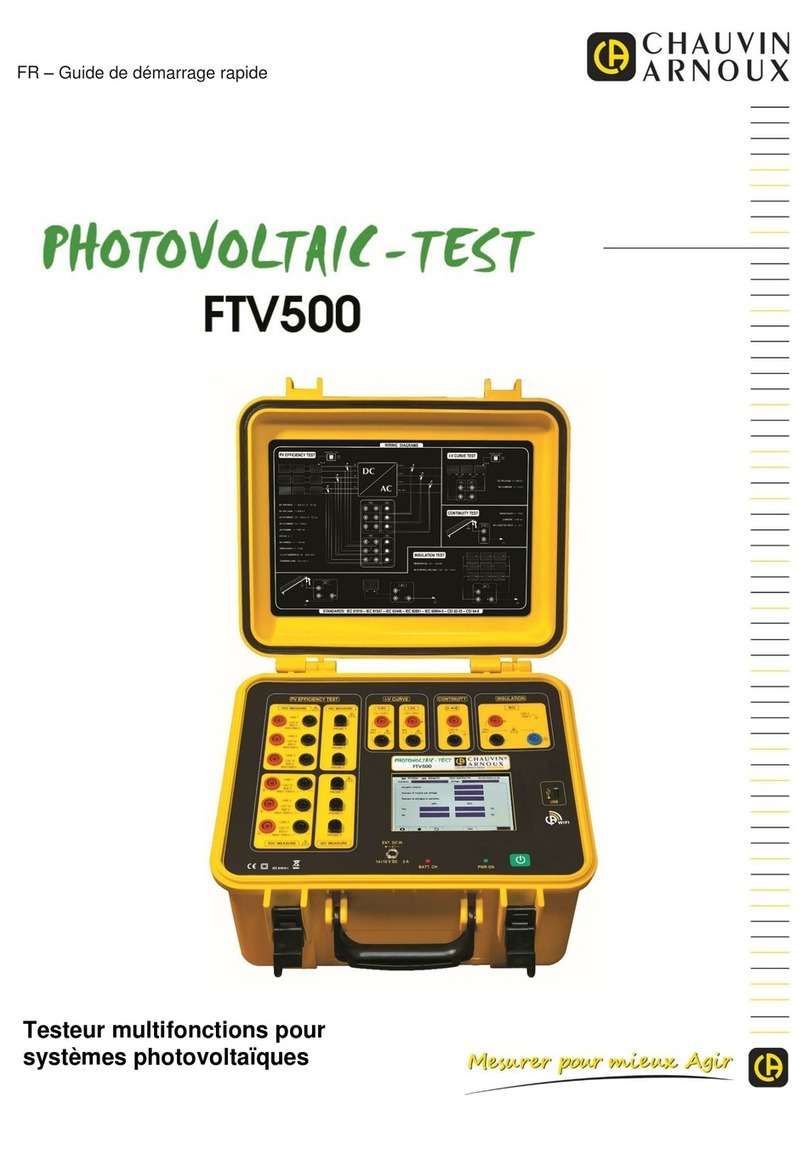
Chauvin Arnoux
Chauvin Arnoux FTV500 quick start guide
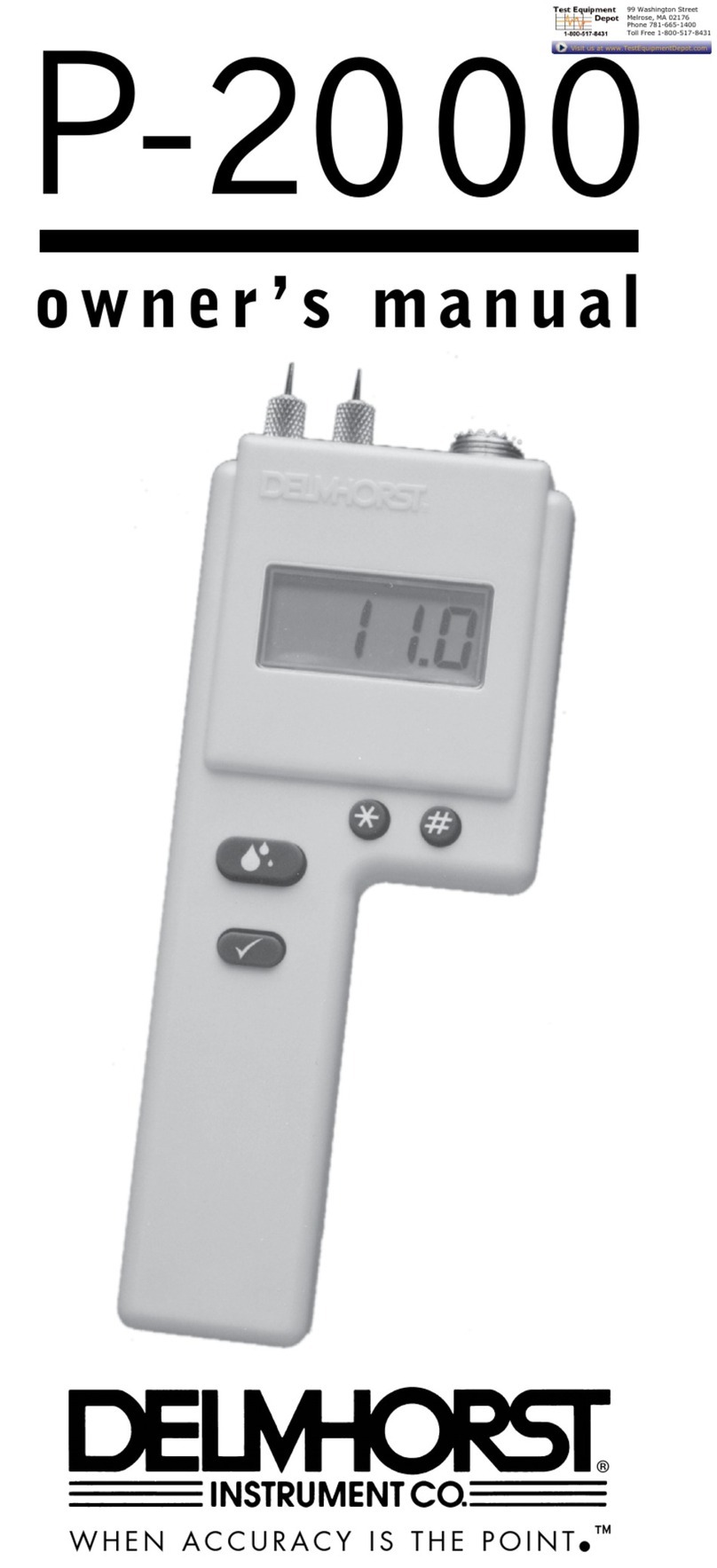
Delmhorst Instrument Co
Delmhorst Instrument Co P-2000 owner's manual
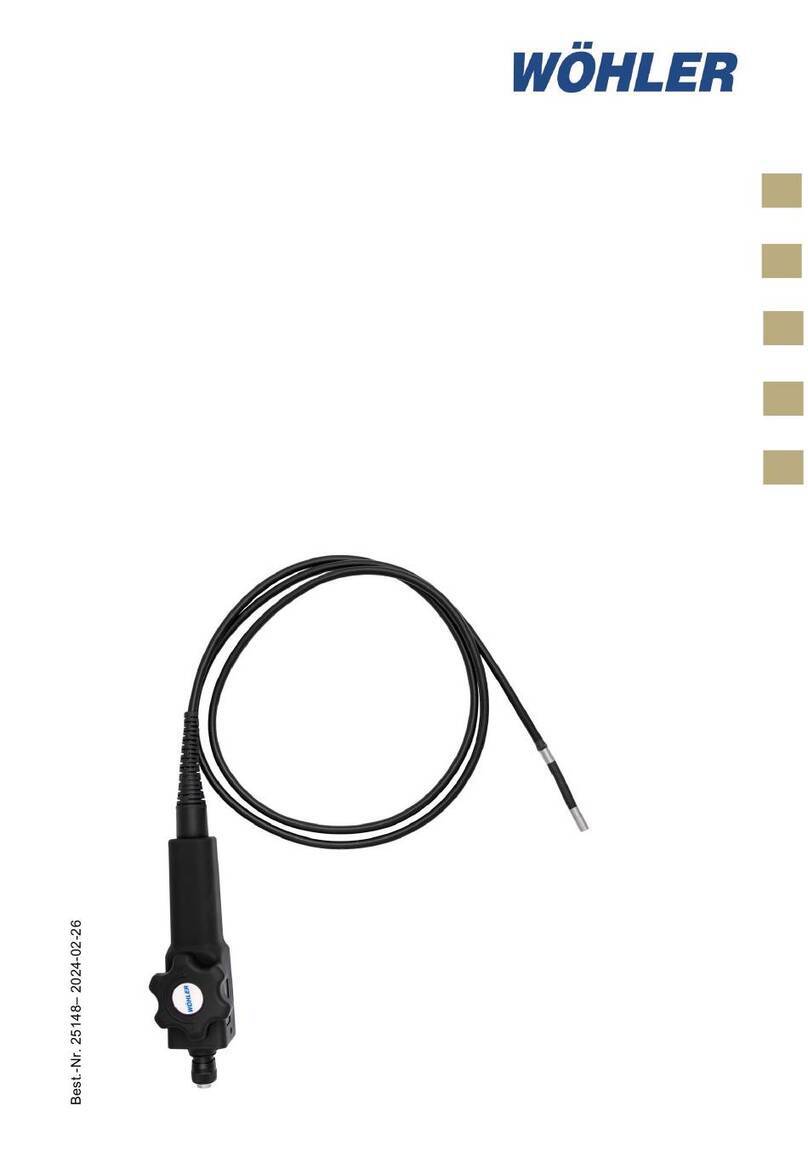
Wohler
Wohler VE operating manual
